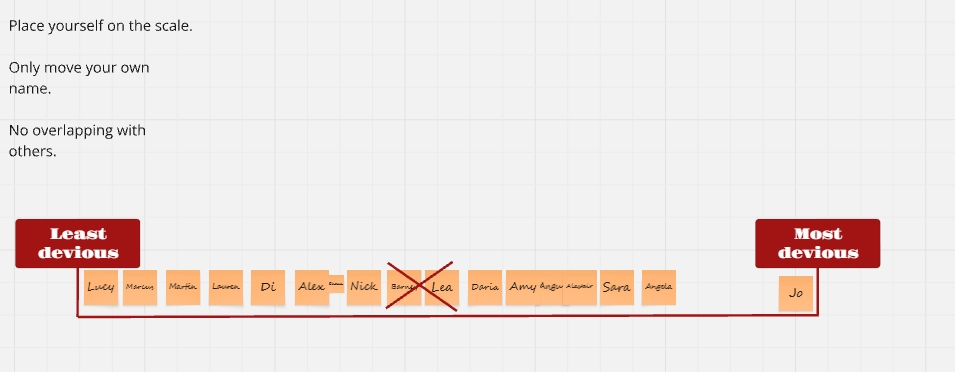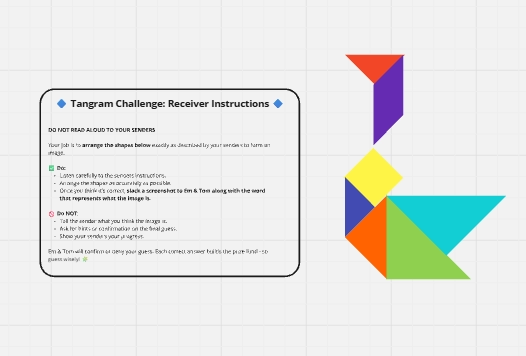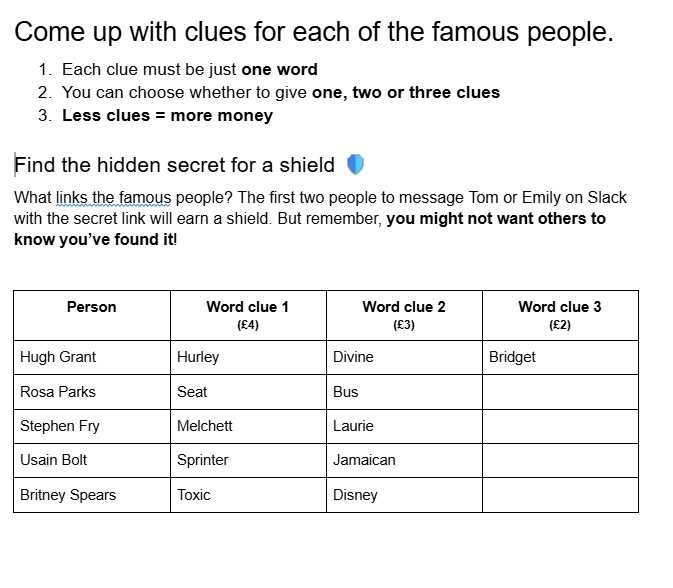Team building is essential, especially when you’re working in a hybrid setup (like us at Dash 👋). But traditional team-building activities can often feel a bit… forced.
Few things inspire more dread than a round of “let’s all share something interesting about ourselves.” (I’m in a cold sweat just thinking about it.)
So, instead of an awkward teambuilding activity (and because our team is obsessed with the show) we created our own version of The Traitors. We played it over five weeks, built challenges that worked remotely, and even hired one of the real-life players to record a cameo 👀.
Here’s how we pulled it off, and how you can run your own.
What is The Traitors (and why does it make a great workplace game?)
The Traitors is a social deduction game that first aired on the BBC in 2023. A group of players spend four weeks in a Scottish castle, competing challenges to build up a prize pot, all while trying to figure out who among them is trying to sabotage the game.
Most players are faithful, but a handful (usually three people) are chosen to be traitors. Their mission is to quietly work against the group, committing ‘murders’ every night. Each week ends with a banishment vote where all players will debate who should be eliminated from the game.
The goal is simple: if the faithful eliminate all traitors, they share the prize.
But if even one traitor survives to the end, the traitor(s) will take the entire pot. 😈
It’s ideal for the workplace because it’s genuinely fun. And although it does take time to prepare (and you’ll need to get your boss on board) we guarantee it’ll be worth it.
Let’s dig into the steps you need to create your own game. 👇
How to plan The Traitors in the workplace
You don’t need a film crew or a Scottish castle to run The Traitors at work. A few apps, a bit of prep, and a willing host are all it takes to get started. Here’s what worked for us:
[fs-toc-omit] 1. A host to run the game
In the TV show, Claudia Winkelman (UK) and Alan Cumming (US) are the linchpins that carry the game forward.
In your workplace-based game, your host will need to assign roles, design challenges, send announcements, and keep the game moving. Plus a good host keeps things fair but isn’t afraid to stir the pot with a few twists.
Chances are things will get a little complicated, so we recommend you have two hosts because there’s a lot of work to do. They’ll need to run the round tables, communicate with players and keep track of the scores. They’ll also need to create challenges, hide shields and drop twists throughout the game.
[fs-toc-omit] 2. Communication channels
We used Slack to run most of the game. Here are some key channels we recommend:
- A public channel for announcements, murder reveals and prize updates.
- A private traitor channel where the host and traitors can collude.
A Traitors Uncloaked channel where eliminated players can spectate and gossip without influencing the game.
[fs-toc-omit] 3. Pick a schedule
We spread our game over 5 weeks. People are busy, so it was important we didn’t encroach on their schedules too often. However, we also needed to balance out the timing so people didn’t lose interest. Here’s what worked for us:
- We used Google Meet for each meeting (but Zoom would work just as well):
- Tuesday mornings were when the challenges took place. We booked 30-minutes in everyone's calendar.
- Tuesday afternoons were when the murders took place. A private meeting happened between the Traitors and the host (this took 10-minutes max).
- On Wednesday mornings hosts announced the murder on the public Slack channel.
- And on Thursday lunchtime we had 30-minutes for all players to have a round table debate where they decided who was going to be banished.
Note: Eliminated players could also join as long as they had cameras and microphones off 🔇.
[fs-toc-omit] 4. A prize fund
Everyone loves a good incentive, and it means people will stay engaged. Luckily, our bosses agreed to contribute towards a prize fund. But other options could be to reward an extra day off to winning player (s) or gifts like a hamper or voucher.
[fs-toc-omit] 5. Visuals and communication templates
One thing that made it easier for our hosts to manage the game was to pre-prepare visuals and templates. For example, you could have:
- A gallery wall created in Canva as a nod to the iconic wall in the show, where the portraits of eliminated players are removed each breakfast.

- A prize-pot tracker - this helped us keep track of how much money the team had earned after each challenge. Tom, our developer, built a live visual tracker that he updated after every round, showing the growing total and how close we were to the final prize. You don’t need to get technical though — a simple graphic in Canva or a shared spreadsheet works just as well.

- Slack message templates: You can prepare some of your Slack messages in advance. For example, you know the traitors are going to eliminate a player every Tuesday, so the host can get their messages prepared for the following day. Here’s an example from our own game:

5 The Traitors challenges that work virtually
Want some inspiration for challenges? Here’s what we did:
1. The devious ranking scale
We framed this as a lighthearted icebreaker, but it secretly kicked the game off. Each player had to place their own name on a shared scale based on how devious they thought they were. Once everyone had chosen their spot, the two players who ended up in the middle were immediately eliminated from the game (sorry Barney and Lea😇) . Of course, they weren’t gone forever — the host later revealed they could be brought back in a future round.
Tools used: Miro - but any virtual whiteboard would work for this.

2. Tangram challenge
Using Miro boards, we split into breakout rooms with two senders and two receivers. Senders could see the finished tangram picture, receivers only had the shapes. The senders described how to arrange the shapes without saying what the final image was. The receivers then had to message the host and tell them what they thought the images were.
Here’s what a receiver saw, for example:

Tools used: Miro (again) - but any virtual whiteboard would work for this.
3. Famous people word clue game
Players split into small teams and opened a shared document filled with names of famous people. Their job was to come up with short, one-word clues to help another team guess each name. The fewer clues they used, the more money they could earn for the prize pot:
- One clue = £4
- Two clues = £3
- Three clues = £2
Once everyone had written their clues, teams swapped sheets and tried to guess the names based on what they’d been given. (Here’s a peek at one of the sheets).

Tools used: Google Docs to write down answers
🛡️Shield opportunity: if someone spotted the hidden link between all the names, they won a shield.
4. Social perception challenge
For this round, the traitors had to secretly answer a set of personal questions in advance. During the game, everyone else had to work out the answers. The faithful debated and compared notes, while the traitors used their insider knowledge to quietly steer the group off course.
🛡️Shield opportunity: before the game started, players had to vote on a leader to provide the final answers to the host. Secretly, this person was then given the power to award another player with a shield.
5. The Traitors quiz
We ran a short general knowledge quiz, with each correct answer adding money to the prize pot. Some questions included:
- Who was the first player to be eliminated?
- How many shields have been awarded so far?
It felt more relaxed, but still gave the traitors a chance to interfere. They were able to slip in wrong answers or nudge the team off track. 👀
Managing engagement and fairness
Part of the fun of The Traitors is the scheming that happens outside the main events. We encouraged players to form alliances and send private messages. (This meant people were able to concoct some wild theories 😵💫).
Plus once players were murdered or banished, we didn’t want them to feel left out. Instead, they were added to a separate Traitors Uncloaked channel where they could watch the game unfold and share theories without influencing the outcome.
And while the game brought plenty of drama, it never felt like a burden. Challenges and round tables were capped at 30 minutes each, so the whole thing slotted neatly around people’s work schedules.
Some final surprises
It didn’t end at the challenges. Our hosts wanted to add a couple of extra twists that none of the players suspected. These are totally optional of course:
[fs-toc-omit] Messages from friends and family
Once we were down to just a handful of players, the hosts reached out to their family and friends and persuaded them to record a video message. The videos were then shared during a morning meeting. Some videos were really heartwarming 🥰 others were pretty hilarious. A big shout out to all those who got involved with that! 👏
[fs-toc-omit] A Cameo from Diane
Finally, our hosts hired Diane Carson- one of the players from season 2 - to send us a message on Cameo. Nobody was expecting this, but it really felt it took the game to the next level. 🙌
The Traitors is the perfect remote-hybrid team building activity
Running our own version of The Traitors started as an experiment, but it quickly became one of the most fun and memorable socials we’ve done as a team. It got people talking, working together and seeing new sides of each other you just don’t get in day-to-day work. And because we ran everything through Slack, Miro and Google Meet, it slotted neatly into our existing workflows without disrupting the week.
If you’re looking for a fresh way to bring your team closer (and spark a bit of friendly chaos while you’re at it), give The Traitors a try. All you need is a host, a plan and a Slack workspace ready for plotting and paranoia. And who knows — you might just uncover the most devious side of your colleagues yet. 👀

.avif)

